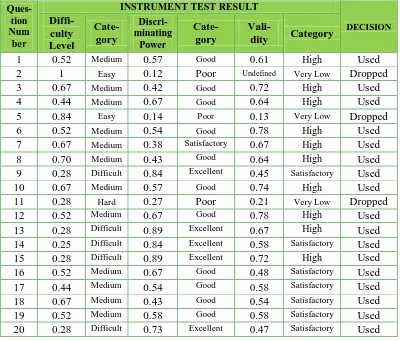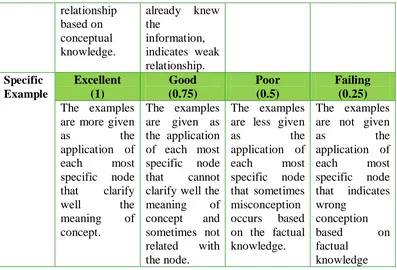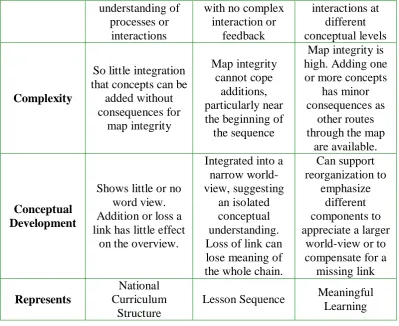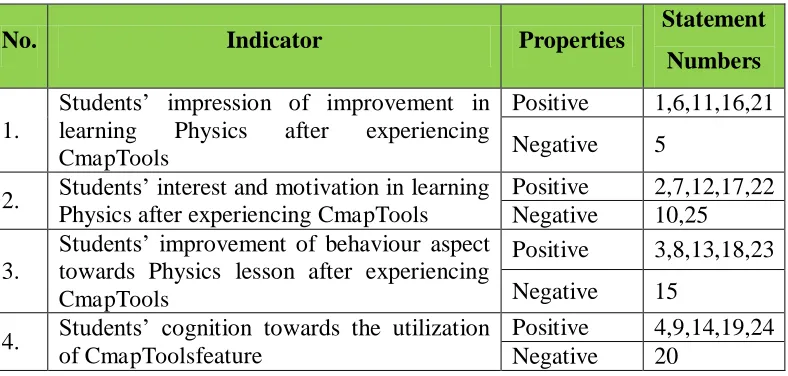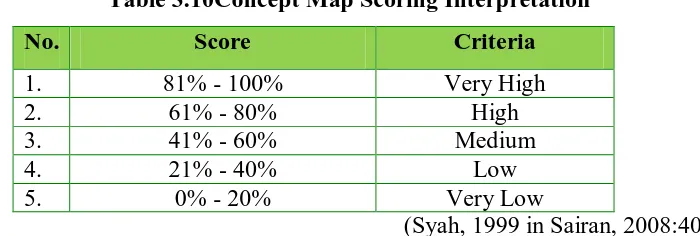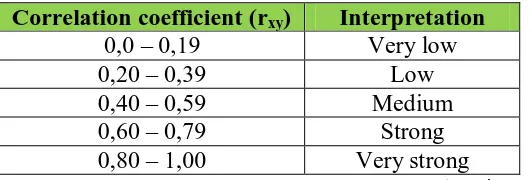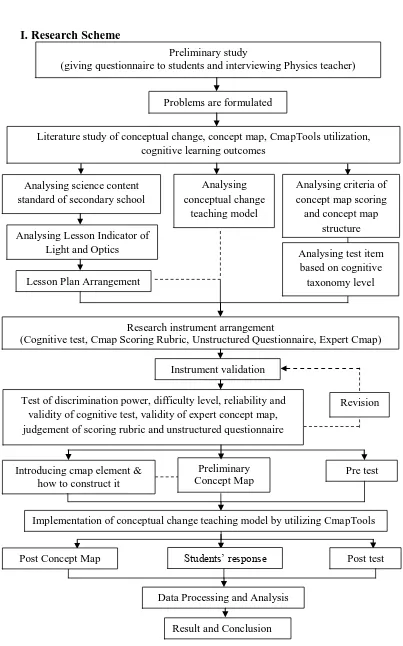Muhammad Rifqi Rofiuddin, 2014
Application Of Five-Stage Conceptual Teaching Model By Utilizing Cmaptools To Analyze Conceptual Change And Cognitive Learning Outcomes On Light And Optics Topic
Universitas Pendidikan Indonesia | repository.upi.edu | perpustakaan.upi.edu CHAPTER III
RESEARCH METHODOLOGY
A. Location and Subject
1. Research Location and Period
The research was conducted at International School in Bandung, West Java that applied 2013 Curriculum during instructional process. Data is obtained in the period of May until June 2014.
2. Population and Sample
Population is defined as generalization consists of objects or subjects that cover whole quality and specific properties; meanwhile sample is a part of whole quality and specific properties of population (Sugiyono, 2008:118)
The population of this research is all of students’ significance in conceptual change and cognitive learning outcomes that belongs to all secondary students in the school. Samplings are selected by purposive sample technique since researcher has the specific objective. The sample is all of students’ significance in conceptual change and cognitive learning outcomes under the topic of light and optics that consists of 22 students of VIII Grade.
B. Research Method and Design
1. Research Method
Muhammad Rifqi Rofiuddin, 2014
Application Of Five-Stage Conceptual Teaching Model By Utilizing Cmaptools To Analyze Conceptual Change And Cognitive Learning Outcomes On Light And Optics Topic
Universitas Pendidikan Indonesia | repository.upi.edu | perpustakaan.upi.edu
mapping the preliminary and post concept map is required in order to analyze its relation towards cognitive learning outcomes that is assessed quantitatively through statistical means; therefore mixed method is developed in this research. Research variables are classified into two; independent variable (X) and dependent variable (Y) that is affected by the treatment process. Five-stage conceptual teaching model by utilizing CmapTools is the independent variable, whereas the dependent variable is students’ cognitive learning outcomes.
2. Research Design
Type of mixed method design that is applied in this research is convergent parallel that simultaneously collect both quantitative and qualitative data, merge the data and use the results to understand research problem. The datasets is analyzed separately based on its own indicator in order to make interpretation as to whether the results support or contradict each other that provides a convergence of data sources (Creswell, 2011).
Students’ preliminary and post concept map will be analyzed qualitatively based on the scoring rubric that is developed by researcher and experts based on Novak’s criteria (1984, in Karakuyu, 2010) including concept map pattern based on Kinchin (1999 in Hay and Adams, 2000). Concept elaboration of each individual that is developed can be analyzed descriptively based on comparison of preliminary and post concept map construction. Qualitative investigation is also concern on students’ ability in linking concept node to various resources by utilizing CmapTools to understand their thinking process.
Quantitative analysis focuses on students’ cognitive learning outcomes that is obtained from pretest and posttest result by statistical calculation in order to investigate achievement in each cognitive domain; from C1 (remembering) until C4 (analyzing).
Muhammad Rifqi Rofiuddin, 2014
Application Of Five-Stage Conceptual Teaching Model By Utilizing Cmaptools To Analyze Conceptual Change And Cognitive Learning Outcomes On Light And Optics Topic
Universitas Pendidikan Indonesia | repository.upi.edu | perpustakaan.upi.edu
Figure 3.1 below represents the convergent parallel design for better understanding.
Qualitative Data Collection and Analysis
(Preliminary - Post Concept map)
Quantitative Data Collection and Analysis
(Pretest - Posttest)
Figure 3.1 Type of Mixed Method Design; Convergent Parallel (Cresswell, 2012: 541)
C. Operational Definition
Operational definition is required in order to give the clarity of the research that has to be suitable with the expected aims; that described as follows:
1. Conceptual change is the significance change of students’ conception in learning Light and Optics based on comparison of preliminary and post concept map construction that emphasizes on significance changing of concept map criteria intorelationship, hierarchical structure, cross link and specific example as well as significance changing of concept map structure into spoke, chain or netunder five stage conceptual teaching model consists of orientation, elicitation, restructure, application and review change of ideas. 2. Concept map is a visual set of concepts aims to answer focus question.
According to Novak (1984) concept map is constructed under four elements;
Interpretation
Five-stage conceptual teaching model (Driver &Odham) by
utilizing CmapTools
Muhammad Rifqi Rofiuddin, 2014
Application Of Five-Stage Conceptual Teaching Model By Utilizing Cmaptools To Analyze Conceptual Change And Cognitive Learning Outcomes On Light And Optics Topic
Universitas Pendidikan Indonesia | repository.upi.edu | perpustakaan.upi.edu
such as (1) prepositions is the connection among concept node through the inclusion of meaningful an informative linking words that represents students’ understanding, (2) hierarchical structure based on arrangement from inclusive to exclusive concepts represents concept organization and classification, (3) cross links is the interconnection among concepts in different map segments or domain represents mapping complexity and analysis ability, and (4) example of specific concept node represents concept application.
3. Cognitive learning outcomes is the competencies of students to achieve cognitive dimension after utilizing CmapTools that is determined from C1 (remembering) – C2 (understanding) – C3 (applying) and C4 (analyzing) in learning Light and Optics through pretest and posttest that consists of 25 multiple questions.
4. CmapToolsthat is used in this research is a prototype media developed by
IHMC (Institute of Human and Machine Cognition) that aims to mapping students’ conceptual change based on concept map construction. CmapTools has benefits to link concept node into various learning resources that is used for qualitative analysis to investigate students’ visual learning.
5. Students’ response towards CmapTools utilization is classified into four criteria such as; (1) impression of improvement in learning Physics,(2) interest and motivation towards Physics lesson, (3) improvement of behavior aspect towards Physics lesson, and (4) cognition towards the benefits of
CmapTools feature.
D. Research Instrument
The research instrument that is applied for collecting data in this research consists of:
Muhammad Rifqi Rofiuddin, 2014
Application Of Five-Stage Conceptual Teaching Model By Utilizing Cmaptools To Analyze Conceptual Change And Cognitive Learning Outcomes On Light And Optics Topic
Universitas Pendidikan Indonesia | repository.upi.edu | perpustakaan.upi.edu
and concept map structure rubric (Table 3.7) that aims to analyze changing of map structure that is obtained from preliminary and post concept map construction.
2. Improvement of students’ cognitive learning outcomes is analyzed by implementing objective test (Appendix B.1) in form of multiple questions with four distractors that is obtyained from pretest and posttest.
3. Students’ response towards CmapTools utilization in learning Light and Optics is analyzed based on unstructured questionnaire form (Appendix B.2) that emphasizes on four indicator such as; (1)impression of improvement in learning Physics, (2) interest and motivation towards Physics lesson, (3) improvement of behavior aspect towards Physics lesson, and (4) cognition towards the benefits of CmapTools feature.
E. Instrument Development and Analysis
Research instruments development is initiated with the content analysis of 2013 curriculum that is used in school. Expert concept map as main reference for scoring students’ concept map for investigating conceptual change has to be developed first by the researcher under suggestion from Physics expert (Appendix B.3). The expert concept map is formulated based on the applicable content that has to be suitable with the ability of secondary students.
Muhammad Rifqi Rofiuddin, 2014
Application Of Five-Stage Conceptual Teaching Model By Utilizing Cmaptools To Analyze Conceptual Change And Cognitive Learning Outcomes On Light And Optics Topic
Universitas Pendidikan Indonesia | repository.upi.edu | perpustakaan.upi.edu
accordance with the questions statement. The instrument analysis of objective test requires levels of difficulty, discriminating power validity and reliability.
1. Instrument Test Requirements a. Level of Difficulty
Good quality question has to be arranged in balanced; the proportion should not consist of whole easy or hard questions, since easy question will not stimulate students to spend more effort in answering as well as hard questions will make students desperate and doesn’t have any motivation to solve it (Arikunto, 2013: 222). Consideration of difficulty level is based on proportion of problem categories easy, medium and difficult. The formula to determine levels of difficulty is represented as follow:
.
� = �
Where:
P= difficulty level
B = number of students who answer correctly N= Total number of students
(Arikunto, 2013: 224)
Classification of difficulty level based on Arikunto is represented on Table 3.1 as follow:
Table 3.1Interpretation of Difficulty Level
No. Difficulty Value Criteria
1. 0.00 – 0.30 Hard
2. 0.31 – 0.70 Middle
3. 0.71 – 1.00 Easy
Muhammad Rifqi Rofiuddin, 2014
Application Of Five-Stage Conceptual Teaching Model By Utilizing Cmaptools To Analyze Conceptual Change And Cognitive Learning Outcomes On Light And Optics Topic
Universitas Pendidikan Indonesia | repository.upi.edu | perpustakaan.upi.edu b. Discriminating Power
Discriminating power is defined as the ability of particular question to distinguish students who classified as higher achievement and lower achievement. The amount of higher achievement students who can answer more particular questions compared to lower achievement means that those questions have positive discriminating power index (Arikunto, 2013: 226). Discriminating power index shows the scale from minus one until positive one, with the negative represents lower discriminating power index and vice versa. The formula to determine the discriminating power is represented below followed by criteria as seen on Table 3.2
DP =
�
−
�Where:
DP = Discriminating Power
Ba = The number of upper group that answer correctly Ja = Total of students in upper group
Bb = The number of upper group that answer incorrectly Jb = Total of students in lower group
(Arikunto, 2013: 228)
Table 3.2Interpretation of Discriminator Power
No. Discriminating Power Value Criteria
1. 0.00 – 0.20 Poor
2. 0.21 – 0.40 Satisfactory
3. 0.41 – 0.70 Good
4. 0.71 – 1.00 Excellent
Muhammad Rifqi Rofiuddin, 2014
Application Of Five-Stage Conceptual Teaching Model By Utilizing Cmaptools To Analyze Conceptual Change And Cognitive Learning Outcomes On Light And Optics Topic
Universitas Pendidikan Indonesia | repository.upi.edu | perpustakaan.upi.edu
…….. (3.3) c. Validity
Validity is defined as the extent to which the instrument measures what it is designed to measure that emphasizes not on the test itself, but on the result (Arikunto, 2013: 80). Validity which is used in this study is Construct Validity since each question item is formulated based on Cognitive Taxonomy. Arikunto (2013:83) describe construct validity measures thinking aspect based on logical; such as classified question item into cognitive dimension. The formula to determine validity is shown below followed by Table 3.3 that interprets the classification of coefficient correlation criteria.
=
−( ) ( )2
−( )2 2−( )2
Where:
= coefficient correlation or item validity
= sum of total score of all students for each question’s item = sum of total score of all students for whole test
N = total number of students
X = score of each student for each question’s item Y = total score of each student
(Arikunto, 2013: 87)
Table 3.3Interpretation of Validity
No. Value Criteria
1. 0,80 < r ≤ 1,00 Very High
2. 0,60 < r ≤ 0,80 High
3. 0,40 < r ≤ 0,60 Satisfactory
4. 0,20 < r ≤ 0,40 Low
5. 0,00 ≤ r ≤ 0,20 Very Low
Muhammad Rifqi Rofiuddin, 2014
Application Of Five-Stage Conceptual Teaching Model By Utilizing Cmaptools To Analyze Conceptual Change And Cognitive Learning Outcomes On Light And Optics Topic
Universitas Pendidikan Indonesia | repository.upi.edu | perpustakaan.upi.edu d. Reliability
Reliability is defined as the extent to which a questionnaire, test, observation or any measurement procedure produces the same results on repeated trials. In short, it is the stability or consistency of scores over time or across raters (Arikunto, 2013: 101). The split-half method using KR 20 equation is used to calculate reliability of the test by giving score one for correct answer and zero for wrong answer (Arikunto, 2013: 108).The equation is described as follow:
r
11= (
−1
)(1-
²)
Where:
r11 = instrument reliability k = amount of test item
∑pq = multiplication result of p and q s = deviation standard
The reliability interpretation represents on the table below.
Table 3.4Interpretation of Reliability
(Arikunto, 2013: 109) Reliability coefficient Criteria
0.00 <r ≤ 0.20 Very low 0.20 <r ≤ 0.40 Low
0.40 <r ≤ 0.60 Satisfactory 0.60 <r ≤ 0.80 High 0.80 <r ≤ 1.00 Very high
Muhammad Rifqi Rofiuddin, 2014
Application Of Five-Stage Conceptual Teaching Model By Utilizing Cmaptools To Analyze Conceptual Change And Cognitive Learning Outcomes On Light And Optics Topic
Universitas Pendidikan Indonesia | repository.upi.edu | perpustakaan.upi.edu e. Recapitulation of Students’ Cognitive Outcomes Instrument
Objective test for measuring students’ cognitive learning outcomes in form of 30 questions has to be tested in terms of difficulty level, discriminating power, validity and reliability that are given to 25 students grade IX who already gained the material of Light and Optics before. Decision based on test requirement result can be used, dropped, or revised with experts related with the probability of particular question item to be used. The recapitulation of objective test as well as specification for each question item is represented on following table and Appendix C.3 for more distinct result.
Test item recapitulation :
Reliability test : 0. 81 (Very High)
Table 3.5Recapitulation of Test Item for Students’ Cognitive Outcomes
Ques-9 0.28 Difficult 0.84 Excellent 0.45 Satisfactory Used
10 0.67 Medium 0.57 Good 0.74 High Used
11 0.28 Hard 0.27 Poor 0.21 Very Low Dropped
12 0.52 Medium 0.67 Good 0.78 High Used
13 0.28 Difficult 0.89 Excellent 0.67 High Used 14 0.25 Difficult 0.84 Excellent 0.58 Satisfactory Used
15 0.28 Difficult 0.89 Excellent 0.72 High Used 16 0.52 Medium 0.67 Good 0.48 Satisfactory Used
17 0.44 Medium 0.54 Good 0.58 Satisfactory Used
18 0.67 Medium 0.43 Good 0.54 Satisfactory Used
19 0.52 Medium 0.58 Good 0.58 Satisfactory Used
Muhammad Rifqi Rofiuddin, 2014
Application Of Five-Stage Conceptual Teaching Model By Utilizing Cmaptools To Analyze Conceptual Change And Cognitive Learning Outcomes On Light And Optics Topic
Universitas Pendidikan Indonesia | repository.upi.edu | perpustakaan.upi.edu
21 0.52 Medium 0.48 Good 0.78 High Used
22 0.67 Medium 0.77 Excellent 0.54 Satisfactory Used
23 0.28 Difficult 0.74 Excellent 0.67 High Used
24 0.44 Medium 0.48 Good 0.42 Satisfactory Used
25 0.81 Easy 0.10 Poor 0.13 Very Low Dropped
26 0.77 Easy 0.12 Poor 0.19 Very Low Dropped
27 0.44 Medium 0.57 Good 0.78 High Used
28 0.52 Medium 0.57 Good 0.53 Satisfactory Used
29 0.67 Medium 0.71 Excellent 0.67 High Used
30 0.52 Medium 0.87 Excellent 0.75 High Used
2. Instrument Non-Test Requirements
a. Rubrics
Concept map scoring and concept map structure are two main rubrics that are applied in this research. Concept map scoring rubric is designed based on Novak and Gowin(1984) that covers four main elements such as preposition, hierarchical level, cross link and example that aims to analyse significance of conceptual change that is obtained from preliminary and post concept map construction. Concept map structure is adapted based on Kinchin and Hay (2000) that concern on the pattern of concept map into spoke, chain or net that represents the conceptual changing. Concept map scoring rubric is elaborated by the researcher and revised based on related experts’ recommendation that utilizes scale to calculate students’ concept map score compared to expert concept map.
b. Questionnaire
Muhammad Rifqi Rofiuddin, 2014
Application Of Five-Stage Conceptual Teaching Model By Utilizing Cmaptools To Analyze Conceptual Change And Cognitive Learning Outcomes On Light And Optics Topic
Universitas Pendidikan Indonesia | repository.upi.edu | perpustakaan.upi.edu F. Data Collection Technique
Qualitative and quantitative data that is obtained in this research requires different collection technique as well as scoring method. Qualitative data is obtained from preliminary and post concept map construction that empathizes on conceptual change based on significance changing of students’ concept map scoring as well as concept map structure. Meanwhile quantitative data concern on cognitive learning outcomes emphasizes on changing in each cognitive level that is obtained from pretest and posttest. Data collection techniques are explained a follow:
1. Data of Students’ Conceptual Change based on Concept Map Scoring
Students’ conceptual change that is obtained from preliminary and post concept map construction is assessed by Concept map scoring rubric. Scoring based on Novak and Gowin (1984) such valid preposition is one, hierarchical structure is five, cross link is ten, and specific example is one for each meaningful mapping is used as maximum score. Each element is elaborated into four different criteria such as excellent-good-poor-and failing that aims to differentiate each student’s concept map quality after whole preliminary and post concept map is collected. Scoring will be divided by four in order to indicate each indicator that represents different characteristics under discussion with experts.
Table 3.6Concept Map Scoring Rubric
Element SCORING ELABORATION
Preposi-Muhammad Rifqi Rofiuddin, 2014
Application Of Five-Stage Conceptual Teaching Model By Utilizing Cmaptools To Analyze Conceptual Change And Cognitive Learning Outcomes On Light And Optics Topic
Universitas Pendidikan Indonesia | repository.upi.edu | perpustakaan.upi.edu essential
Muhammad Rifqi Rofiuddin, 2014
Application Of Five-Stage Conceptual Teaching Model By Utilizing Cmaptools To Analyze Conceptual Change And Cognitive Learning Outcomes On Light And Optics Topic
Universitas Pendidikan Indonesia | repository.upi.edu | perpustakaan.upi.edu relationship
2. Data of Students’ Conceptual Change based on Concept Map Structure
Significance changing of concept map structure that is obtained from preliminary and post concept map structure represents well restructure of ideas that illustrate how students change their conception. Qualitative approach that aims to investigate concept map pattern for analyzing conceptual change is developed by Kinchin and Hay (2000: 48). They classified concept map structure into spoke, chain and net as seen on Figure 2.2.a, 2.2.b, and 2.2.c that emphasizes on hierarchy level, processes, complexity, conceptual development and representation as seen on Table 3.7 as follow:
Table 3.7Concept Map Structure Rubric
Aspect Map Type
Processes Simple association with no
Shown as a temporal sequence
Muhammad Rifqi Rofiuddin, 2014
Application Of Five-Stage Conceptual Teaching Model By Utilizing Cmaptools To Analyze Conceptual Change And Cognitive Learning Outcomes On Light And Optics Topic
Universitas Pendidikan Indonesia | repository.upi.edu | perpustakaan.upi.edu understanding of that concepts can be
added without
Shows little or no word view. Addition or loss a link has little effect
on the overview.
Lesson Sequence Meaningful Learning
3. Data of Students’ Cognitive Learning Outcomes
Students’ cognitive learning outcomes in each cognitive level are obtained two times based on pretest and posttest. Test is carried out with the form of multiple choices using 25 test items under the topic of Light and Optics. Objective test is formulated based on factual and conceptual knowledge in the form of multiple choices using four options with the cognitive dimension as C1 (remembering), C2 (Understanding), C3 (Applying), and C4 (Analyzing). The blueprint of the objective test is shown based on table 3.8 below represents proportion for each cognitive level.
Table 3.8Blueprint of Objective Questions
No Subtopic
s Learning Objective
Specification
C1 C2 C3 C4
1. Properties of Light Correlate the properties of
Muhammad Rifqi Rofiuddin, 2014
Application Of Five-Stage Conceptual Teaching Model By Utilizing Cmaptools To Analyze Conceptual Change And Cognitive Learning Outcomes On Light And Optics Topic
Universitas Pendidikan Indonesia | repository.upi.edu | perpustakaan.upi.edu straight line based on daily diffusion reflection on the rough surface using diagram.
3 Interpret concept of Law of
Reflection and image formation in plane mirror
4,5 Apply geometrical optic
formula in curved mirror 11,12
Analyze nature of image formation in curved mirror
13,14, light refraction indaily life phenomena
6,7 Determine ray between two
mediums with different density based on Snell’s Law
8 Analyse the form of
refraction using ray diagram based on refraction index
9 Apply geometrical optic
formula in lenses
18,19, 21,22
Analyse nature of image
formation in lenses 20,23
Exemplify the principle of
4. Data of Students’ Response
Muhammad Rifqi Rofiuddin, 2014
Application Of Five-Stage Conceptual Teaching Model By Utilizing Cmaptools To Analyze Conceptual Change And Cognitive Learning Outcomes On Light And Optics Topic
Universitas Pendidikan Indonesia | repository.upi.edu | perpustakaan.upi.edu
lesson, (3) improvement of behavior aspect towards Physics lesson, and (4) cognition towards the benefits of CmapTools feature. There are 25 statements with the inclusion of 5 questions that states negative statement in order to control students’ answer. This attitude scale uses Likert with four points of type scale (absolutely agree, agree, do not agree, absolutely do not agree) based on Measurement of Successive Interval (MSI) computation. Type of scale which states do not agree is prevented in order to make the clarity of student’s response after experiencing CmapTools. Scoring of positive statement is given point 5 until 1 orderly from strongly agree until strongly disagree criteria; whereas scoring of negative statement is vice versa. The blueprint is represented based on Table 3.9 as follow:
Table 3.9Blueprint of Students’ Response Questionnaire
No. Indicator Properties Statement
Numbers
1.
Students’ impression of improvement in learning Physics after experiencing CmapTools
Positive 1,6,11,16,21 Negative 5
2. Students’ interest and motivation in learning Physics after experiencing CmapTools
Positive 2,7,12,17,22 Negative 10,25 3.
Students’ improvement of behaviour aspect towards Physics lesson after experiencing CmapTools
Positive 3,8,13,18,23 Negative 15
4. Students’ cognition towards the utilization
of CmapToolsfeature
Positive 4,9,14,19,24 Negative 20
G. Data Processing and Analysis
Muhammad Rifqi Rofiuddin, 2014
Application Of Five-Stage Conceptual Teaching Model By Utilizing Cmaptools To Analyze Conceptual Change And Cognitive Learning Outcomes On Light And Optics Topic
Universitas Pendidikan Indonesia | repository.upi.edu | perpustakaan.upi.edu
………….. (3.6) 1. Data Processingof Students’ Conceptual Change
Students’ concept map that is obtained twice in preliminary and post implementation in order to illustrate significance of conceptual change will be assessed based on concept map scoring rubric (Table 3.6). Expert concept map that is already developed by researcher together with Physics expert is used as maximum score. Concept map scoring isrepresented as follow including the score interpretation on Table 3.10.
=
( � ) 100%……. (3.5)
Table 3.10Concept Map Scoring Interpretation
No. Score Criteria
1. 81% - 100% Very High
2. 61% - 80% High
3. 41% - 60% Medium
4. 21% - 40% Low
5. 0% - 20% Very Low
(Syah, 1999 in Sairan, 2008:40) 2. Data Processingof Students’ Cognitive Learning Outcomes
Objective test that consists of 25 multiple questions based on arrngemet of cognitive level from C1 (remember) until C4 (analysing) will be assessed based on scoring. For each correct answer will be given score 1 whereas wrong answer will be given score 0.Scores then will be converted into 0-100 scale value.The score conversion in form percentage (%) represents based on this equation:
Table 3.11Category Scale of Students’ Score
Score Category
S ≤ 40 Very poor
41 ≤ S ≤ 55 Poor
Muhammad Rifqi Rofiuddin, 2014
Application Of Five-Stage Conceptual Teaching Model By Utilizing Cmaptools To Analyze Conceptual Change And Cognitive Learning Outcomes On Light And Optics Topic
Universitas Pendidikan Indonesia | repository.upi.edu | perpustakaan.upi.edu 56 ≤ S ≤ 65 Satisfactory
66 ≤ S ≤ 80 Good
81 ≤ S ≤ 100 Excellent
(Arikunto 2013: 281)\
Gain score (actual gain) was obtained from the difference of pre-test score and post-test score. The difference in pre-test scores and the post-test is assumed as the effect of the intervention. Normalized gain calculations are intended to determine the categories of students’ achievement improvement. According to Hake (1999) normalized gain is calculated by using this following formula:
� = −
(Hake, 1999) Where :
G = Gain
= Post-test score = Pre-test score
The improvement of cognitive learning outcomes in learning Light and Opticsafter utilizing CmapToolsfor constructing concept maps will be seen from the result of the normalized gain that achieved by students. For the calculation of the normalized gain value and its classification will use equations as follows:
Where:
<g> = Normalized gain G = Actual gain
Gmax = Maximum gain possible Sf = Post-test score
Si = Pre-test score
(Hake, 1999) < >= %�
%� =
(% −% )
(100−% )
………….. (3.7)
Muhammad Rifqi Rofiuddin, 2014
Application Of Five-Stage Conceptual Teaching Model By Utilizing Cmaptools To Analyze Conceptual Change And Cognitive Learning Outcomes On Light And Optics Topic
Universitas Pendidikan Indonesia | repository.upi.edu | perpustakaan.upi.edu
The value of <g> is determined based on criteria below on the table below:
Table 3.12Criteria of N Gain Improvement N-Gain <g> Improvement Criteria
0,00 – 0,29 Low
0,30 – 0,69 Medium
0,70 – 1,00 High
(Hake, 1999)
3. Data Processing of Students’ Response towards CmapTools Utilization
Qualitative analysis of students’ response is carried out in order to analyze students’ interest, motivation, impression and cognition towards the implementation of using CmapTools in constructing concept map. Processing is executed by calculating Likert scale into score then percentage conversion. The formula of converting score into percentage is seen below followed by scoring guideline of Likert scale that is represented on Table 3.13 as follow:
Score = � ����
�� ���� ���� x 100%
(Arikunto, 2013: 262) Table 3.13Scoring Guideline of Students’ Response
Strongly
Disagree Disagree Not sure Agree
Strongly Agree
Negative Statement 5 4 3 2 1
Positive Statement 1 2 3 4 5
(Sugiyono, 2008: 203) The interpretation of score percentage is categorized into certain criteria according to Arikunto (2013) is represented as follows.
Tabel 3.14Percentage Interpretation of Questionnaire
Percentage(%) Criteria
0% None
0 %- 25% A few of criteria
26%-40% Almost half of
Muhammad Rifqi Rofiuddin, 2014
Application Of Five-Stage Conceptual Teaching Model By Utilizing Cmaptools To Analyze Conceptual Change And Cognitive Learning Outcomes On Light And Optics Topic
Universitas Pendidikan Indonesia | repository.upi.edu | perpustakaan.upi.edu
41%-50% Half of
51%- 75% Mostly
76%-99% Generally
100% All of them
(Arikunto, 2013: 263)
4. Data Analysis and Hypothesis Test
a. Normality Test
Parametric statistic is implemented in this research since it aims to measure the parameter of particular sample that has normal distribution. If the distribution is free, non-parametric statistic is used. Parametric statistic is more valid and powerful compared to non-parametric related with interval and ratio data; if the assumptions are reasonably met (Phopan, 1973 in Sugiyono, 2008: 211). Normality test is executed in order to analyze whether samples comes from population that has normal distribution or not. SPSS version 17.0 is used as supporting software to determine normality test for each pretest and posttest based on Kolmogorov-Smirnov. Data is considered as normal distribution if the criterion is higher than assumption of significance in two-tailed.
b. Hypothesis Test
Hypothesis test is measured based on Pearson correlation product moment by utilizing SPSS version 17.0. Since in this research the hypothesis arrangement emphasizes on the significance correlation between conceptual change based on
CmapTools utilization and cognitive learning outcomes, it is classified as
Muhammad Rifqi Rofiuddin, 2014
Application Of Five-Stage Conceptual Teaching Model By Utilizing Cmaptools To Analyze Conceptual Change And Cognitive Learning Outcomes On Light And Optics Topic
Universitas Pendidikan Indonesia | repository.upi.edu | perpustakaan.upi.edu Table 3.15Interpretation of Correlation Coefficient
Correlation coefficient (rxy) Interpretation
0,0 – 0,19 Very low
0,20 – 0,39 Low
0,40 – 0,59 Medium
0,60 – 0,79 Strong
0,80 – 1,00 Very strong
(Sugiyono, 2008: 257)
Determination coefficient can be calculated in order to determine the regression equation as represented by the equation as follow:
= 2 × 100%
Where:
R = Determination coefficient r = Correlation coefficient
(Sugiyono, 2008: 259)
Regression analysis aims to obtain the equation that is used to investigate the prediction of high or low dependent variable value (Y) if the independent variable is being modified or manipulated (Sugiyono, 2008: 261). The equation is represented as follow:
= +
Where:
Y = Value that will be predicted a=Constanta or if the X value is zero b = Regression coefficient
X = Value of independent variable
(Sugiyono, 2008: 259) ……….. (4.0)
Muhammad Rifqi Rofiuddin, 2014
Application Of Five-Stage Conceptual Teaching Model By Utilizing Cmaptools To Analyze Conceptual Change And Cognitive Learning Outcomes On Light And Optics Topic
Universitas Pendidikan Indonesia | repository.upi.edu | perpustakaan.upi.edu H. Research Procedure
This research is carried out into three stages; preparation, implementation and final stage under conceptual change teaching model according to Driver and Oldham. The stage description will be explained as follows:
1. Preparation stage
In the planning stages consists of preliminary study, literature study, and design the research instrument.
a. Preliminary Study
Preliminary study aims to identify the problem in real Physics classroom environmental system. It is useful to find out obstacles which students faced, so questionnaires have to be distributed. A questionnaire consists of ten questions is given to each student one week before entering the lesson stage. Teacher also are being interviewed about several problems that she faced during teach physics. By analyzing the results of both questionnaires and teacher’s interview, research problem can be formulated.
b. Literature Review
Muhammad Rifqi Rofiuddin, 2014
Application Of Five-Stage Conceptual Teaching Model By Utilizing Cmaptools To Analyze Conceptual Change And Cognitive Learning Outcomes On Light And Optics Topic
Universitas Pendidikan Indonesia | repository.upi.edu | perpustakaan.upi.edu c. Research Instrument Design
Research instrument is designed as quantitative and qualitative instrument into test and non-test. Non-test instrument such as concept map scoring rubric under Novak and Gowin’s criteria; preposition, hierarchical level, cross links and examples is developed by researcher together with the related experts as well as adoption of concept map structure rubric based on Kinchin. Researcher also has to developed expert concept map as maximum score to assess students’ concept map based on recommendation of lecturer and supervisors. Questionnaire is developed using Likert scale under four indicators such as (1) impression of improvement in learning Physics,(2) interest and motivation towards Physics lesson, (3) improvement of behavior aspect towards Physics lesson, and (4) cognition towards the benefits of CmapTools feature. Test instrument emphasizes onobjective tests that has to be judged first based on discriminator power, level of difficulty, reliability, and validity using Ms. Excel computation before distributing the questions to the treatment group. Researcher also has to concern with the role
of CmapTools to utilize students in constructing concept map during Light and
Optics so several features has to be optimized first. 2. Implementation Stage
Research implementation is explained as follow:
a. Experimental class determination based on purposive sampling. b. Pretest implementation in order to describe students’ prior conception. c. Processing pretest result.
d. Conduct research activity by implementing conceptual change teaching model based on Driver and Oldham (1986 in Lin et. al., 2010) under following scenarios:
Muhammad Rifqi Rofiuddin, 2014
Application Of Five-Stage Conceptual Teaching Model By Utilizing Cmaptools To Analyze Conceptual Change And Cognitive Learning Outcomes On Light And Optics Topic
Universitas Pendidikan Indonesia | repository.upi.edu | perpustakaan.upi.edu
students report their prior knowledge in order to investigate their prior conception through preliminary concept map construction by answering how light behaves, how light is reflected and refracted as focus question using conventional method or handwriting. Concept Text is used as assistant to helps students elaborate their prior conception.Before constructing preliminary mapping, concept map introduction based on Novak’s criteria into preposition, hierarchical level, cross links, and examples. Preliminary discussion together with students is conducted first to make them realize the differences between concept map and mind map that is usually made. This session also concerns how to construct concept map by classifying and organizing general to specific concepts including linking words formulation to connect each concept node.
2) Second meeting emphasizes on restructure of ideas that is elaborated into first sequence of clarification and exchange based on small group discussion in order to examine and criticize of others’ prior conception related with focus question that is proposed by teacher; “How you can see the twinkling of stars in the night which is really bright? How the
light can propagate to your eyes though the hole of roof in your
house?How is the image that you see if you use the inner part of spoon and
the outer part of spoon? How come a pencil can be bent inside a glass of
Muhammad Rifqi Rofiuddin, 2014
Application Of Five-Stage Conceptual Teaching Model By Utilizing Cmaptools To Analyze Conceptual Change And Cognitive Learning Outcomes On Light And Optics Topic
Universitas Pendidikan Indonesia | repository.upi.edu | perpustakaan.upi.edu
reflection principle including specular and diffuse reflection in order to make students investigate whether the value of angle formation between incident and reflected ray is same or not using laser, plane mirror, rough aluminum, and arc. Experiment also focus on Snell’s law of
refraction by using laser and two baker glasses that is empty and filled with
water. Students have to determine the path of refraction in different medium
density.
3) Third meeting still emphasizes on restructure of ideas phase that is elaborated into sequence of construction of new ideas and evaluation. Students are guided how to draw ray tracing diagram based on light reflection and refraction through teacher demonstration using laser, curved mirror and lenses. Students also are guided how to determine image distance, height and magnification by applying geometrical optic formula as well as nature of image formation analysis based on ray tracing diagram. Evaluation focus to solve problems under small group discussion.
4) Fourth meeting emphasizes on application of ideas by utilizing
CmapTools. Teacher introduce CmapTools’ feature such making
Muhammad Rifqi Rofiuddin, 2014
Application Of Five-Stage Conceptual Teaching Model By Utilizing Cmaptools To Analyze Conceptual Change And Cognitive Learning Outcomes On Light And Optics Topic
Universitas Pendidikan Indonesia | repository.upi.edu | perpustakaan.upi.edu e. Posttest implementation to analyze gain in each cognitive level.
f. Questionnaire distribution to investigate students’ response towards
CmapTools utilization.
3. Final Stage
Muhammad Rifqi Rofiuddin, 2014
Application Of Five-Stage Conceptual Teaching Model By Utilizing Cmaptools To Analyze Conceptual Change And Cognitive Learning Outcomes On Light And Optics Topic
Universitas Pendidikan Indonesia | repository.upi.edu | perpustakaan.upi.edu I. Research Scheme
Preliminary study
(giving questionnaire to students and interviewing Physics teacher)
Literature study of conceptual change, concept map, CmapTools utilization, cognitive learning outcomes
Analysing criteria of concept map scoring and concept map
structure
Lesson Plan Arrangement
Research instrument arrangement
(Cognitive test, Cmap Scoring Rubric, Unstructured Questionnaire, Expert Cmap)
Instrument validation
Test of discrimination power, difficulty level, reliability and validity of cognitive test, validity of expert concept map, judgement of scoring rubric and unstructured questionnaire
Preliminary Concept Map
Implementation of conceptual change teaching model by utilizing CmapTools
Students’ response
Data Processing and Analysis
Result and Conclusion
Revision Analysing Lesson Indicator of
Light and Optics Analysing science content standard of secondary school
Problems are formulated
Analysing conceptual change
teaching model
Analysing test item based on cognitive
taxonomy level
Pre test Introducing cmap element &
how to construct it
Post Concept Map Post test

